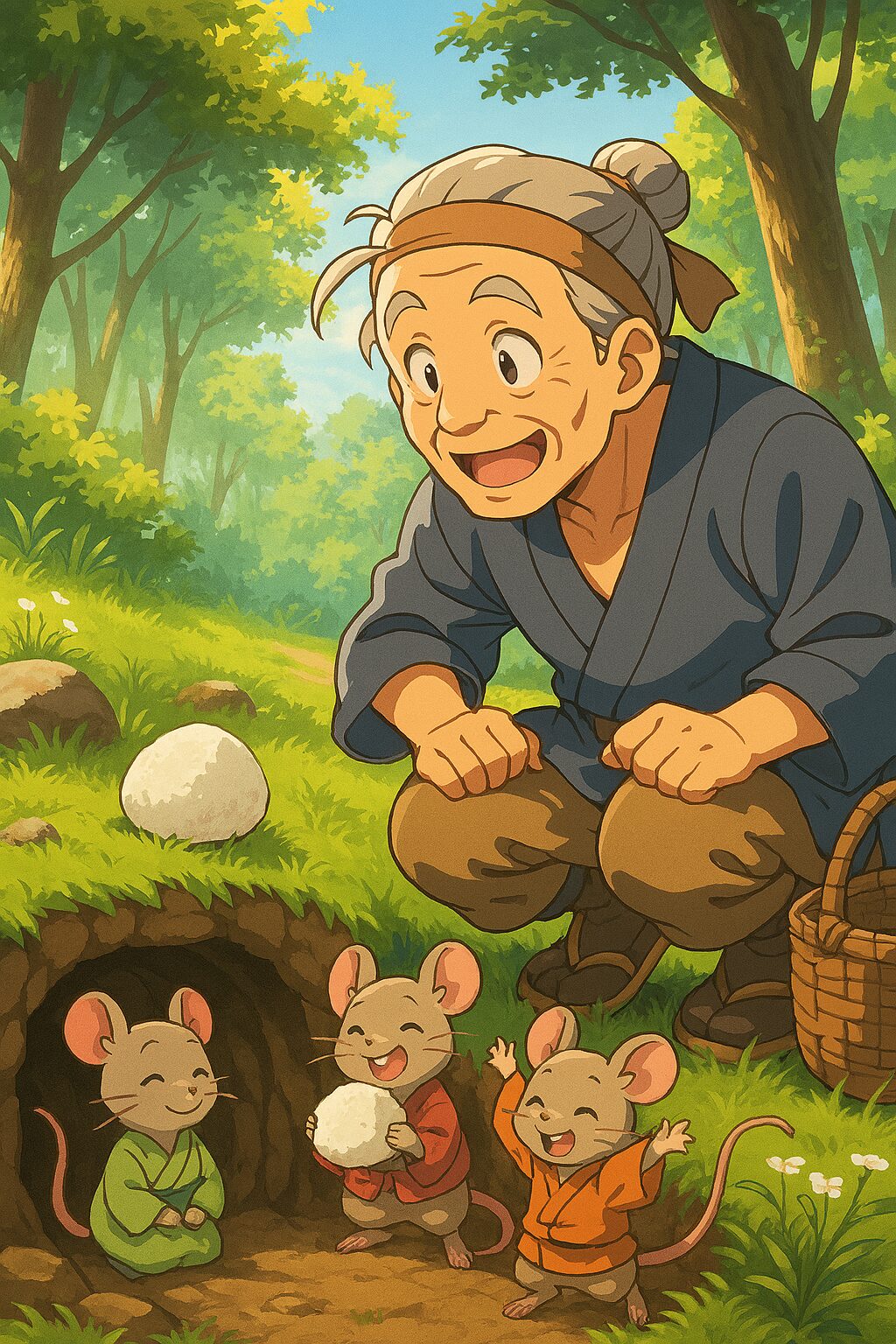- Introduction: The Richness of Heart in Japanese Folktales
- 🐭The Story: A Rice Ball Opens the Door to an Underground World
- 😈The Greedy Neighbor: A Lesson in Humility
- 🍙Cultural Background: What Is an Omusubi?
- 🌏Cultural Context and External Links
- 💡Modern Relevance: What Omusubi Kororin Teaches Us Today
- 📝Conclusion: A Rolling Rice Ball and the Wisdom It Carries
- はじめに:昔話が語る「心の豊かさ」
- 🐭物語:転がるおむすびが開いた、地下のふしぎな世界
- 😈もう一人のおじいさん:欲深さが招く結末
- 🍙「おむすび」の文化的背景
- 🌏海外読者への文化解説とリンク
- 💡現代とのつながり:おむすびころりんの再解釈
- 📝まとめ:転がるおむすびが教えてくれること
Introduction: The Richness of Heart in Japanese Folktales
Japan has a long tradition of folktales passed down through generations. Among them, Omusubi Kororin—literally “The Rice Ball That Rolled Away”—is a simple yet profound story loved by children and adults alike.
It’s not just about a rice ball rolling into a hole. It’s a tale of honesty, harmony with nature, and kindness without expectation. This article introduces the story and its cultural significance in a way that’s easy to understand for international readers unfamiliar with Japanese traditions.
🐭The Story: A Rice Ball Opens the Door to an Underground World
Once upon a time, in a quiet mountain village, there lived a kind old man. One day, while gathering firewood in the hills, he sat down to eat his lunch—a homemade rice ball.
As he unwrapped it, the rice ball slipped from his hand and began to roll…
“Oh no! Come back!” he cried, but the rice ball rolled and rolled, until it fell into a small hole in the ground.
Curious, the old man peeked into the hole. To his surprise, he heard cheerful singing:
♪ Omusubi kororin, sutton-ton
♪ Kororin sutton, sutton-ton
Inside the hole was a hidden world of mice—tiny houses, dancing mice, and joyful celebration. The mice were delighted by the rice ball and invited the old man to join them.
They served him delicious food, sang songs, and danced. Touched by their hospitality, the old man enjoyed a magical time underground. As he prepared to leave, the mice gave him a treasure chest as a token of gratitude.
Back home, he opened the chest to find it filled with gold and jewels. It was a reward for his honesty and kindness.
😈The Greedy Neighbor: A Lesson in Humility
The old man’s greedy neighbor heard the story and decided to imitate him. He dropped a rice ball into the hole and entered the mice’s world, but his behavior was rude and demanding.
Though the mice reluctantly gave him a chest, when he opened it at home, it was filled with ghosts and snakes! Terrified, he ran away, learning that greed leads to misfortune.
🍙Cultural Background: What Is an Omusubi?
Omusubi (also called onigiri) is a traditional Japanese food made by shaping cooked rice into triangles or balls, often with fillings like pickled plum, grilled salmon, or seaweed. It’s portable, simple, and deeply rooted in Japanese daily life.
In this story, the rice ball symbolizes generosity and connection. It’s not just food—it’s a bridge between worlds, between humans and nature.
🌏Cultural Context and External Links
Japanese folktales often feature animals that talk, dance, and live in hidden worlds. Mice are seen as clever and communal creatures, appearing in other tales like “The Mice’s Sumo.”
These stories reflect values like honesty, humility, and respect for nature—core principles in Japanese society.
- Japanese Folktales – University of Pittsburgh
- Watch Omusubi Kororin on YouTube
- Nippon.com – Explore Japanese Culture in English
💡Modern Relevance: What Omusubi Kororin Teaches Us Today
- Kindness Without Expectation
In today’s social media age, we often seek likes or recognition. This story reminds us of the beauty of giving without asking for anything in return. - Harmony with Nature
The mice’s underground world represents nature’s hidden richness. Respecting small lives and ecosystems is more important than ever. - Diversity and Empathy
Connecting with different beings—like mice—teaches us to embrace diversity and treat others with compassion.
📝Conclusion: A Rolling Rice Ball and the Wisdom It Carries
Omusubi Kororin is more than a children’s tale. It’s a story about living honestly, respecting nature, and giving generously. These are values that transcend borders and time.
Japanese folktales offer deep insights wrapped in simple narratives. As adults, we can rediscover their wisdom and apply it to our modern lives. Why not let a humble rice ball roll into your heart today?
🍙おむすびころりん:穴の中に広がる、やさしさと知恵の世界
はじめに:昔話が語る「心の豊かさ」
日本には、世代を超えて語り継がれてきた「昔話」が数多く存在します。その中でも「おむすびころりん」は、素朴ながらも深い教訓を含んだ物語として、子どもから大人まで親しまれてきました。
この物語は、ただのおにぎりが転がる話ではありません。正直者の生き方、自然との調和、そして「見返りを求めない優しさ」が描かれています。この記事では、日本文化に馴染みのない海外の読者にもわかりやすく、「おむすびころりん」の魅力をたっぷりとご紹介します。
🐭物語:転がるおむすびが開いた、地下のふしぎな世界
昔々、ある山里に、心のやさしいおじいさんが住んでいました。ある日、お昼に持ってきたおむすびを食べようとしたところ、手元がすべって、おむすびがころころと転がってしまいます。
おむすびは、ころころころりん…と、地面の小さな穴の中へ吸い込まれるように落ちていきました。穴の中からは、楽しげな歌声が聞こえてきます。
♪ おむすびころりん すっとんとん
♪ ころりんすっとん すっとんとん
穴の中には、ネズミたちの世界が広がっていました。ネズミたちは、おむすびを喜び、おじいさんを歓迎します。ごちそうや踊りで楽しい時間を過ごしたおじいさんは、帰りに宝物の入ったつづらをもらいます。
😈もう一人のおじいさん:欲深さが招く結末
隣の欲張りなおじいさんは、真似をして穴に入りますが、礼儀を欠いた振る舞いをしたため、ネズミたちに嫌われてしまいます。つづらを持ち帰って開けると、中からはお化けやヘビが飛び出してきて、驚いて逃げ出しました。
🍙「おむすび」の文化的背景
「おむすび」は、日本の伝統的な携帯食で、炊いた米を手で握って作ります。梅干し、鮭、昆布などの具材が入り、昔から山仕事や遠出の際の弁当として親しまれてきました。
物語の中でおむすびがネズミたちとの交流のきっかけになるのは、偶然ではなく、「人と人を結ぶ」象徴としての意味合いが込められています。
🌏海外読者への文化解説とリンク
- Japanese Folktales – University of Pittsburgh
- YouTubeで見る「Omusubi Kororin」
- Nippon.com – 日本文化を英語で紹介する総合サイト
💡現代とのつながり:おむすびころりんの再解釈
- SNS時代の「見返りを求めない優しさ」
見返りを求めずに行動することの美しさを教えてくれます。 - サステナビリティと自然との共生
地下のネズミたちの世界は、自然の豊かさを象徴しています。 - 多様性と共感の価値
異なる存在との交流を通じて、偏見なく接することの大切さを学べます。
📝まとめ:転がるおむすびが教えてくれること
「おむすびころりん」は、正直に生きること、自然を大切にすること、そして見返りを求めない優しさという普遍的な価値を伝えてくれます。
日本の昔話は、ただの子ども向けの読み物ではありません。大人になってからこそ、その奥深さに気づくことができます。ぜひ、あなたも「おむすびころりん」の世界に足を踏み入れてみてください。



コメント